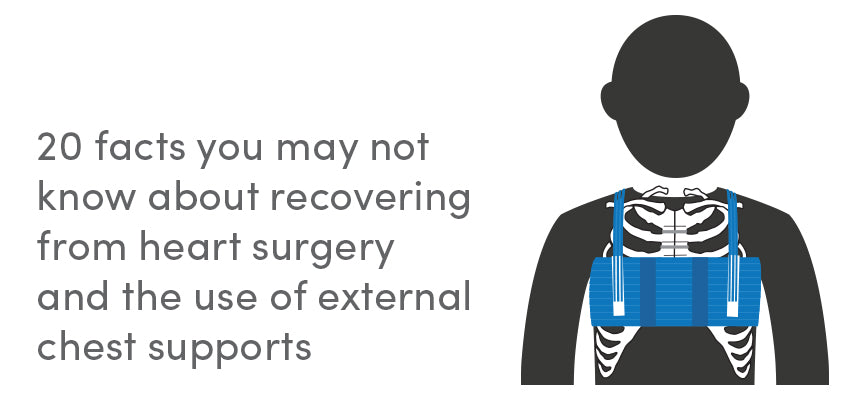Here are 20 facts that you may or may not know about postoperative recovery after heart surgery and the complications that may arise.
These points are extracted from the recently published White Paper from D. Hjorth titled: "Evaluation of external chest supports based on the entire recovery process in and out of the hospital to avoid offset costs of long term complications and medications."
Read the White Paper and find the related references here.
These points are extracted from the recently published White Paper from D. Hjorth titled: "Evaluation of external chest supports based on the entire recovery process in and out of the hospital to avoid offset costs of long term complications and medications."
Read the White Paper and find the related references here.

Scar from open heart surgery
- Surgical techniques continue to improve, yet the rate of complications after a sternotomy procedure are still significant and stable, and cost the health care system enormous sums.
- Statistically, in a hospital performing 1000 annual cases, the incidence of deep sternal wound infections averages at 3 patients per month with a cost of +/- $ 65,000 per case. That is an additional cost of +/- $2.3 mill. annually.
- More than half of these complications are diagnosed after discharge.
- According to statistics a "1000-annual-cases" hospital has more than 400 patients with pulmonary complications which adds $28,000 per case, and over 300 patients with persistent postoperative pain adding costs of $6,000 per case.
- There is no clear agreement on guidelines for postoperative care concerning best breathing and upper limb exercises in the hospital or at home, and recommendations vary from hospital to hospital, from country to country, and there is limited control on how strictly patients follow recommendations after discharge.
- The soft tissue heals in 4 to 5 weeks, and the sternum bone takes 6 to 8 weeks to heal.
- Patients are discharged as early as possible. This shifts the responsibility for recovery and wound care from the hospital staff to the patients themselves, their family or other caretakers.
- When the two sternal halves are retracted to opposite sides during the surgery, it will cause considerable strain on the anatomy of the chest, back, shoulders and neck, and result in musculoskeletal and neurological complaints.
-
Pain causes reluctance to breathe deeply and to cough which impedes a proper lung clearance for atelectasis and secretions.
Pain slows down early mobilisation and exercise of the upper limbs which in turn slows down the blood supply to the fractured sternum.
- Patients may not receive sufficient pain medication due to their concern for addiction, and staff may not offer pain medication out of standard regimes if patients do not ask.
- A successful recovery depends on how clearly patients are instructed, have understood the instructions, and what tools they have available to assist their daily day activities at home.
-
An external chest support which firmly, comfortably compliments the internal sternal closure, relieves pain and assists respiratory exercises, can only increase the odds for an optimal alignment of the two sternal halves and a complication-free healing of the sternum.
- The decision to choose a specific device must be based on how it can improve the patient’s entire recovery process, and how comfortable it is to use in order to secure patient compliance with usage in the hospital and at home for up to 8 weeks.
- QualiBreath and QualiBra Advanced are the only dual-functional devices. They give a constant, firm, lateral support on the sternum, and have a patient-activated additional circumferential support for coughing, sneezing and other painful situations.
- All other external chest support devices are single-functional, and are either a constant chest compression device, or a patient-activated cough support device.
- Single-functional devices with patient-activated cough support have no constant effect on the sternum, pain or respiration, and can only assist with coughing if the patient reacts in time.
- Single-functional devices with a constant compression on the chest have no extra means of support for coughing, and must fit extremely tight to counteract the sudden high internal pressure during coughing and/or sneezing, which make these devices extremely uncomfortable and painful to use for the patients.
- A firm, constant support on the chest has been shown to decrease deep sternal wound infections in several external chest devices. If such device decreases deep sternal wound infections but has no effect on superficial sternal infections and causes discomfort, pain and restrains activities, the cost savings are most likely to be offset by other complications and long term medications.
- QualiBreath is the only device that has been documented to have a positive effect on sternal instability, pain relief, ease of breathing, comfort, patient function, ease of activities and exercise.
- QualiBreath and QualiBra Advanced, which incorporates a mini-QualiBreath, are the most comfortable, effective external chest and breast supports available, and are an important adjunctive method to assist the healing sternum, prevent sternal infections, decrease postoperative pain and pulmonary complications, and ultimately decrease health care costs.
When you consider these important facts and that every publication on the clinical use of a variety of external chest supports have revealed significant advantages, it is puzzling why external chest supports are not included routinely in postoperative care to improve recovery, avoid complications and decrease related health care costs.
Let us know your opinion. Leave a comment below.


1 comment
Mar 08, 2019 • Posted by Ganesh Surath
I have undergone AVR in Feb 2018 and developed excessive cough post operation and suffered syncopes. After six months I have throbbing pain in the shoulder and back region which does not allow me to sleep even after taking medicines.. What is the best way to tackle this problem.
Leave a comment: